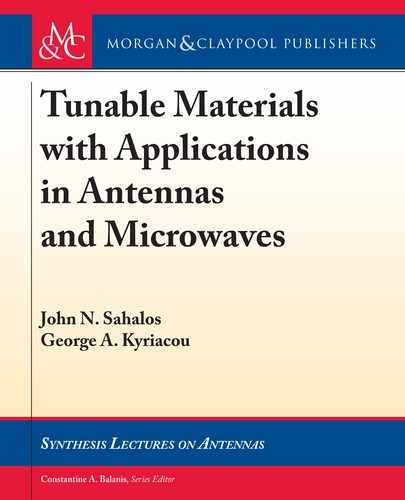
48 2. TUNABLE MATERIALS–CHARACTERISTICS AND CONSTITUTIVE PARAMETERS
10
4
10
6
10
8
10
10
10
12
10
14
10
16
Ionic
Electronic
Radio Infrared
UV
εʹ and εʹʹ
r r
εʹ ≤100
εʹ ≤30
r
r
εʹ ≤10
r
εʹ =1
r
εʹʹ
r
εʹʹ
r
εʹʹ
r
f(Hz)
Dipolar and Related
Relaxation
Microwave
Region
Figure 2.17: e relative contribution of the three polarizability mechanisms to the real and
imaginary part of the dielectric constant ("
r
).
can be reverted to an unpolarized state when the field is removed, and the other, the remnant
class, retains polarization after the field is removed. e latter is usually reversible; in other words,
the polarization direction is reversed when the applied field changes sign. In general, materials
exhibiting a non-zero net electric dipole moment and a corresponding polarization in the ab-
sence of an applied electric field are called “electrets.” On the other hand, materials exhibiting
an individual electric dipole, which in the absence of an applied field are arbitrarily oriented to
yield a zero net total dipole moment and zero polarization, are called “polar materials.”
Finally, materials that retain a reversible net polarization when the field is removed are
called “ferroelectrics” [40, 41]. In a manner similar to that of ferrites, ferroelectrics exhibit small
regions with strongly coupled dipole domain moments, also called “domains.” is strong cou-
pling causes the dipole moments within a domain to be aligned in the same direction. Once
again, as in ferrites, the natural tendency of stored energy minimization leads to multiple do-
mains which have different orientations so that a freshly annealed ferroelectric does not exhibit
spontaneous polarization. When an electric field is applied, the domain walls are moved in such
a way as to enlarge the domains, whose polarization components are in the direction of the
applied field. A further increase in the applied electric field tends to rotate the remaining do-
main dipole moment as a whole in the direction of the applied field. In a manner similar to that
in ferrites, as the electric field is increased, some domains are easily aligned. However, fewer
additional domains are aligned as the field is further increased, which causes a saturation effect.
Saturation polarization depends on temperature, and above a certain characteristic tem-
perature, called the “Curie-Weiss temperature” (T
C
), the thermal vibration-agitation of atoms
becomes a dominant phenomenon and saturation polarization tends to zero; that is, the material
loses its ferroelectric properties. is behavior is described as “paraelectric.”
..................Content has been hidden....................
You can't read the all page of ebook, please click here login for view all page.
